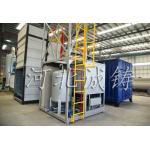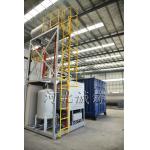1.6t Rendering Plant Cooker For Feather Meal Project
|
|
Rendering Cooker For Feather Meal Project Feather Meal Processing Equipment Hydrolysis of inorganic salts There are four categories: 1. Strong acid and strong base salts do not undergo hydrolysis, because their ionized anions and cations cannot disrupt the ionization balance of water, so they are neutral. 2. Strong acid and weak base salt. We call the weak base part weak cation. The weak base ions combine with the hydroxide ions ionized from the water, destroying the ionization balance of water, causing the ionization of water to move forward, resulting in hydrogen in the solution The ion concentration is greater than the hydroxide ion concentration, making the aqueous solution acidic. 3. Strong base and weak acid salt. We call the weak acid part weak anion. In the same way, the weak anion combines with the hydrogen ions ionized from the water to make the hydroxide ion concentration in the solution greater than the hydrogen ion concentration, making the solution alkaline. 4. Weak acid and weak base salt, the weak acid part combines with hydrogen, and the weak base part combines with hydroxide to generate two weak electrolytes. Then compare their ionization constant Ka and Kb values (rather than the degree of hydrolysis) at one temperature Next, the ionization constant (also called the ionization equilibrium constant) of the weak electrolyte is a fixed value. This comparison can be used to determine what the salt is, and who is strong. The ionization constant is a negative logarithm based on 10. , Whoever has the least burden will be bigger. In a word, the reaction in which the anions and cations in the salt solution combine with the hydrogen ions or hydroxide ions ionized from the water to form a weak electrolyte is called salt hydrolysis.
|
||||||||
| Product Tags: 1.6t Rendering Cooker 1.6t Rendering Plant Cooker |

|
Batch Rendering Cooker Feather Meal Processing Equipment |

|
Carbon Steel Feather Meal Processing Machine Batch Rendering Cooker |

|
Daily 60-80 Tons Carbon Feather Meal Processing Equipment |

|
Feather Meal Line ISO9001 Animal Rendering Plant Carbon Steel |

|
Hydrolyzed Feather Meal Carbon Chicken Rendering Plant |

|
Steel Carbon Feather Meal Poultry Rendering Plant Machine |


